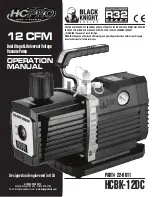
Refrigeration Maintenance and Service Operations
142
6. Then evacuate the system (see “Evacuation
and Cleanup of the Refrigeration System” in
this chapter).
7. Replace the condenser coil support brackets,
condenser fan shroud and condenser fan grille.
8. Recharge the unit with R-134a refrigerant and
check the compressor oil level. Add oil if
necessary.
Dehydrator (Filter Drier)
Replacement
Removal
1. Close the liquid line service valve and pump
down the low side. Open the outlet valve
slightly to equalize the pressure between 10
and 20 kPa, 0.10 and 0.20 bar, 1 and 3 psig.
2. Place the new filter drier near the unit for
immediate installation.
3. Using two wrenches, “crack” both filter drier
line mountings. Use two wrenches on flare
fittings to prevent line damage.
4. Separate the filter drier line mountings.
5. Remove the filter bracket clamping nuts and
bolts.
NOTE: Perform the following four
procedures as quickly as possible to prevent
contamination.
6. Remove the old dehydrator from the line.
Installation
1. Remove the sealing caps from the new
dehydrator.
2. Apply clean compressor oil to dehydrator
threads.
3. Assemble new dehydrator to lines. Finger
tighten mounting nuts.
NOTE: To prevent incorrect installation of
the dehydrator, the inlet and outlet fittings
are different sizes
.
4. Reinstall filter drier clamping brackets, nut
and bolts. Tighten the bolts.
5. Tighten the filter drier inlet line mounting nut.
6. Open the liquid line service valve on the inlet
side of the filter drier slowly to release a small
amount of refrigerant from the receiver tank to
purge the air through the filter. Then tighten
the outlet nut.
NOTE: When removing or replacing the
o-ring nuts on the dehydrator, always hold
the body of the filter drier near the flange
fittings to prevent twisting the tubing when
the nuts are being loosened or tightened.
7. Back seat (open) the liquid line service valve
on the inlet side of the filter drier.
8. Test the filter drier for leaks (see “Refrigerant
Leak Test Procedure” in this chapter)
.
9. If no leaks are found, place the unit in
operation.
Expansion Valve Replacement
Removal
1. Close the liquid line service valve and pump
down the low side to -35 kPa, -0.35 bar, 10 in.
vacuum. Break the vacuum with nitrogen
between 10 and 20 kPa, 0.10 and 0.20 bar, 1
and 3 psig.
2. Remove insulating tape and unclamp feeler
bulb from the suction line in the evaporator.
Note the position of the feeler bulb on the side
of the suction line.
3. Remove insulating tape from expansion valve
outlet line.
4. Heat and unsolder the equalizer line from
expansion valve.
5. Heat and unsolder the liquid line inlet and
outlet connections to expansion valve.
6. Remove expansion valve from unit.
Installation
1. Clean the liquid lines and equalizer lines for
soldering.
2. Place new expansion valve in position in
liquid line.
3. Solder liquid line inlet and outlet line
connections to valve.
Содержание CRR-40 119
Страница 4: ......
Страница 16: ...Safety Precautions 16...
Страница 18: ...Service Guide 18...
Страница 20: ...Model Features 20...
Страница 32: ...Specifications 32...
Страница 120: ...MP 3000a Controller 120...
Страница 160: ...Wiring and Schematic Diagrams Index 160...
Страница 161: ...161 MPC2000 Wiring Schematic...
Страница 162: ...162 MPC2000 High Voltage Wiring Diagram...
Страница 163: ...163 MPC2000 Low Voltage Wiring Diagram...
Страница 164: ...164 MPC2000 WCC Wiring Schematic...
















































